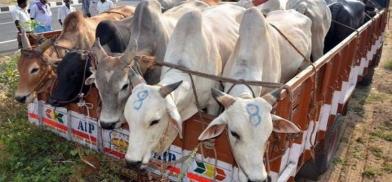Cattle smuggling down sharply at India-Bangladesh border, claims Indian government
In 2015, addressing India's Border Security Force (BSF) personnel at a border outpost in West Bengal, then Home Minister Rajnath Singh (now Defence Minister) had reportedly said that he wanted the force to crack down on cattle smuggling so hard that Bangladeshis - a Muslim majority nation - would quit eating beef

In 2015, addressing India's Border Security Force (BSF) personnel at a border outpost in West Bengal, then Home Minister Rajnath Singh (now Defence Minister) had reportedly said that he wanted the force to crack down on cattle smuggling so hard that Bangladeshis - a Muslim majority nation - would quit eating beef. In official figures from India's Ministry of Home Affairs (MHA) that indicate a fair amount of success in this drive, cattle seizures along the eastern borders have dropped sharply over the past few years - from153,602 in 2015 to just 20,415 till November 2021.
Data of last seven years shows 2018 was a turning point when cattle seizures dropped almost 50 per cent to 63,716 compared with 1,19,299 in 2017. The numbers dropped sharply over the last two years: 46,809 in 2019 and 20,415 in 2021, The Indian Express reported.
Since it gained power in May 2014, the BJP-led government - which has cow protection as one of its national policies with Prime Minister Narendra Modi recently stating that "cow is mother, sacred to us" - has put in special efforts to crack down on the highly lucrative cattle smuggling across the over 4000 km long border between the two countries. Last year, in an official statement, the BSF called cattle smuggling an act of “sedition”.
According to the paper, the force has deployed extra personnel to round-the-clock monitor the border and stop cattle smuggling. It has acquired more speedboats to chase smugglers transporting cattle through the rivers. It has also taken coercive action through lethal and non-lethal weapon firing on such trans-border criminals.
There were other reasons for the sharp drop in cattle seizures. “Earlier, after we seized cattle, it was handed over to customs authorities who auctioned them. The auctioned cattle would most often be bought by the same smugglers who brought them back to the border. This pushed up seizure numbers,” a senior BSF officer was quoted as saying.
In 2018, such auctions were stopped. “Local police were supposed to take possession of seized cattle, but they did not cooperate. So, the BSF took care of the seized cattle with the help of some NGOs and then gave them away to cow shelters. BSF has had to bear expenses, but this brought down seizure numbers,” the officer explained.
Other factors include Bangladesh increasing its own dairy capacity over the years and developments in the hinterland which restricted the transportation of cattle to the border.
The drop in cattle seizures has also coincided with the drop in attacks on BSF personnel by smugglers. From 103 injuries to BSF personnel in 2015, the figure has dropped to just 63 in 2021, according to the MHA. Tens of thousands of cattle heads have been smuggled for years in giant herds on moonless nights with knowledgeable officials saying that the racket had the connivance of Indian and Bangladeshi security and other officials on both sides to meet the endless demand for good beef across the border that also supported the local economy on both sides.
(SAM)








Post a Comment